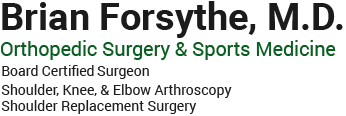Discharge Instructions & Physical Therapy Protocol for Arthroscopic SLAP Repair Type II, Type IV
Initial recovery after shoulder surgery entails healing, controlling swelling and discomfort and regaining some shoulder motion. The following instructions are intended as a guide to help you achieve these goals until your 1 st postoperative visit.
Comfort
Although surgery uses only a few small incisions around the shoulder joint, swelling and discomfort can be present. To minimize discomfort, please do the following
- Ice - Ice controls swelling and discomfort by slowing down the circulation in your shoulder. Place crushed ice in plastic bag over your shoulder for no more than 20 minutes, 3 times a day
- Pain Medication- Take medications as prescribed, but only as often as necessary. Avoid alcohol and driving if you are taking pain medication
- Antibiotic Medication - If an antibiotic has been prescribed, start taking the day of your surgery. The first dose should be around dinnertime. Continue taking until the prescription is finished
- >Sling- A sling has been provided for your comfort and to stabilize your shoulder for proper healing. Continue wearing the sling for a period of approximately six weeks or until Dr. Forsythe directs you to stop
- Driving - Driving is NOT permitted as long as the sling is necessary
Activities
- You are immobilized with a sling and abductor pillow, full time, for approximately the first 6 weeks. Your doctor can tell you when you can discontinue use of the sling at your 1 st postoperative visit. The sling may be removed for exercises
- Your sling may be removed for gentle PASSIVE range-of-motion (PROM) exercises. (SOMEONE ELSE MOVES YOUR SHOULDER). This should be done 3x a day /15 repetitions (ABDUCTION ONLY - away from your body)
- Active range-of motion (AROM - you move your shoulder) should be performed for shoulder internal/external rotation. Keep elbow positioned at the side and flexed at 90° so forearm is parallel to the floor. This should be done within a comfortable range until you feel slight pain (3x a day for 15 repetitions). You can shrug your shoulders
- While your sling is off you should flex and extend your elbow and wrist - (3x a day for 15 repetitions) to avoid elbow stiffness
- Ball squeezes should be done in the sling (3x a day for 15 squeezes)
- You may NOT move your shoulder by yourself in certain directions. NO active flexion (lifting arm up) or abduction (lifting arm away from body) until Dr. Forsythe or your therapist gives permission. These exercises must be done by someone else (Passive Range of Motion)
- Physical therapy will begin approximately 3 - 4 weeks after surgery. Make an appointment with a therapist of your choice for this period of time. You have been given a prescription and instructions for therapy. Please take these with you to your first therapy visit
- Athletic activities such as throwing, lifting, swimming, bicycling, jogging, running, and stop-and-go sports should be avoided until cleared by Dr. Forsythe
Wound Care
- Keep the dressing on, clean and dry for the first 3 days after surgery
- Remove the dressing 3 days after surgery. The steri-strips (small white tape that is directly on the incision areas) should be left on until the first office visit. You may apply band-aids to the small incisions around your shoulder
- You may shower 5 days after surgery with band-aids on. Apply new band-aids after showering
- Tub bathing, swimming, and soaking should be avoided for two weeks after your surgery
Eating
- Your first few meals after surgery should include light, easily digestible foods and plenty of liquids, as some people experience slight nausea as a temporary reaction to anesthesia
Call your physician if
- Pain persists or worsens in the first few days after surgery
- Excessive redness or drainage of cloudy or bloody material from the wounds. (Clear red tinted fluid and some mild drainage should be expected). Drainage of any kind 5 days after surgery should be reported to the doctor
- Temperature elevation greater than 101°
- Pain, swelling, or redness in your arm or hand
- Numbness or weakness in your arm or hand
Return to the office
- Your first return to the office should be within the first 1 - 2 weeks after your surgery. Call Dr. Forsythe's office to make your first postoperative appointment
Rehabilitation Guidelines for Repair SLAP Lesions Type II & Type IV
WEEK 1
Sling immobilization with abductor pillow at all times; gentle elbow, wrist and hand exercises started the day after surgery and continued throughout rehab period.
WEEKS 2 - 4
Continue sling immobilization with abductor pillow. Codman circumduction exercises; gentle passive range-of-motion within pain-free range avoiding external rotation beyond neutral and extension of arm behind body.
WEEKS 4 - 10
Discontinue sling and abductor pillow. Progressive passive range-of-motion to full, as tolerated in all planes; begin passive posterior capsular and internal rotation stretching; begin passive and manual scapulothoracic mobility program; begin external rotation in abduction exercises; begin protected biceps, rotator cuff and scapular stabilizer strengthening; allow use of operative extremity for light activities of daily living.
WEEKS 10 - 16
Begin biceps, rotator cuff and scapular stabilizer resistance exercises; begin sport-specific exercise program.
WEEKS 16 - 24
Begin interval-throwing program on level surface; continue stretching and strengthening programs with special emphasis on posterior capsular stretching.
WEEKS 24 - 28
Begin throwing from the mound
AFTER 28 WEEKS
Allow full velocity throwing from the mound; continue strengthening and posterior capsular stretching indefinitely; since occult posterior capsular tightness had a significant role in the original S.L.A.P. Lesion, stretching this area will limit the chances of recurrence.















